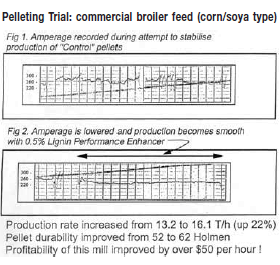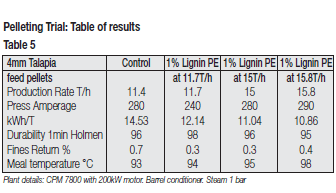Troubleshooting The Pelleting Process: Part 3
Maximizing Pellet Quality/Production Rate
The addition of binders can help solve pellet quality problems or simply lift your pellet quality to a higher plane. Lignin technology has advanced rapidly over the past few years so much so that collectively Lignins have become known as "Lignin Performance Enhancers." Some have been developed to maximize pellet quality, while others to maximize production of the pellet press without compromising pellet quality.
When used to maximize pellet quality (as well as improving production rate) the glue-like properties of lignin maximize the grip between rollers, meal and die making the action of pelleting more positive i.e., reducing roller slip. As the pellets lose moisture in the cooler, the lignin structure within them toughens and strengthens, resulting in pellets of higher durability.
On the other hand, lignins have been developed to maximize production rate (as well as improving pellet quality) by creating "internal body lubrication" which allows the meal particles to mold together more easily, thereby forming pellets with improved structure. Moreover, lubrication extends to the die allowing for higher production rate without losing pellet quality.

Lignin is a cost effective tool which can be used to overcome production and pellet quality problems or as a means to improve overall efficiency. Fig. 1 and Fig. 2 show a pellet press amperage trace recording when producing a commercial poultry feed. During a three hour production run, the pellet press operator encountered 12 complete chokes and 13 interruptions until a 0.5% addition of a specifically formulated lignin production performance enhancer was made. Amperage was immediately reduced and production ran smoothly from then on. Moreover, production rate increased from 13.2 to 16.1 tons/hour, specific energy consumption was reduced from 11.36 to 10 kWh/T and pellet durability increased from 52 to 62 Holmen. The extra tonnage improved the profitability of this mill by $50 per hour.
Table 5/Fig 3 show a similar effect when producing 4 mm Tilapia.
Measurement Of Physical Pellet Quality
"Hardness" , "Durability " and "Appearance" are the main factors associated with the term pellet quality. Hardness is usually measure by a spring type tester. It is advisable to take the average of several readings because of the variability in results.

Durability is the most important aspect of pellet quality. Durability means the ability of pellets to withstand the rigors of handling and delivery without breaking up.
It can be measured in one of two
recognized ways:
"� Mechanically
- Tumbling Can Method or
Pneumatically
"� Holman Tester and Ligno Tester
Appearance is mainly subjective, color, surface texture etc., pellet length, however, an important aspect when a customer makes a visual assessment of your product, can be measured. The generally accepted guideline for a pellet length is 2.5 times its diameter. Measuring average pellet weight is becoming a common method of monitoring changes in pellet quality, by taking a random sample, weighing and counting the pellets to determine average weight, serves to detect changes in pellet length as well as pellet density.
Conclusion
A "Troubleshooting" route in block form provides a summary to help direct you to a speedy solution of pellet quality/production problems you may encounter.
Measuring/monitoring the performance of your plant will enable you to manage it effectively and provide a means of speedily troubleshooting production or pellet quality problems. Moreover, combining your production knowledge with Lignin Technology will enable you to truly maximize pellet quality and production performance, profitably.




